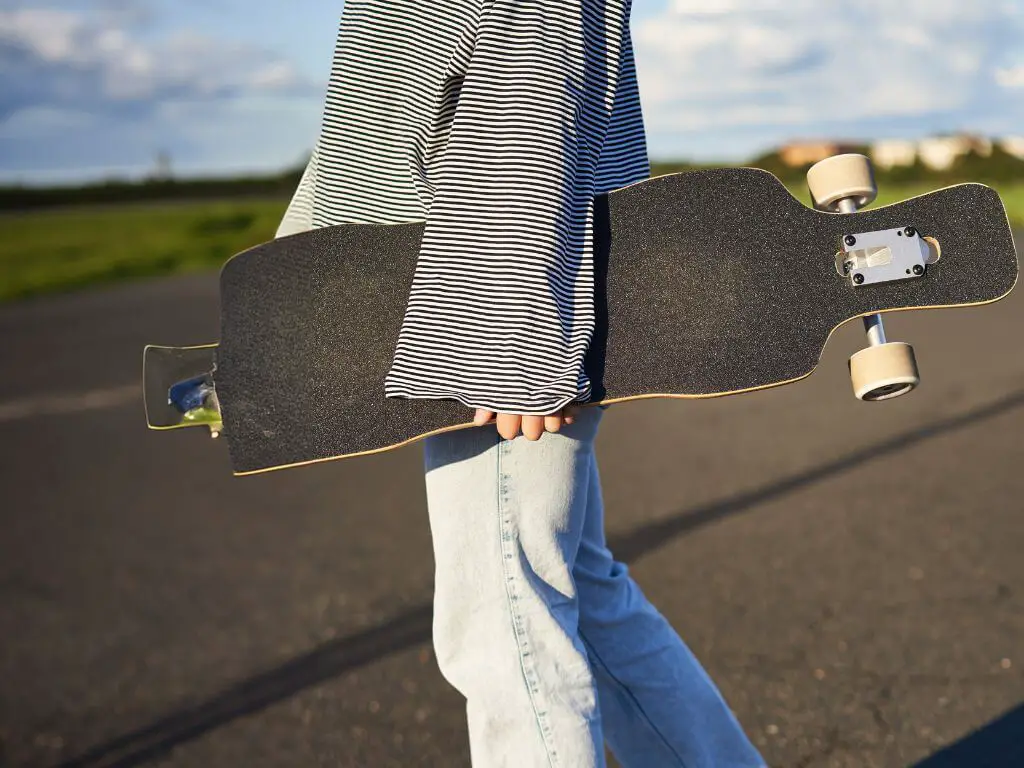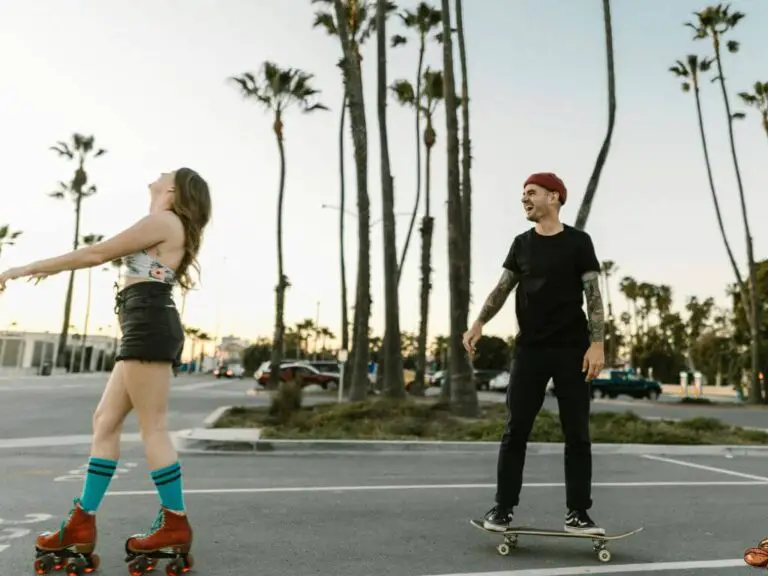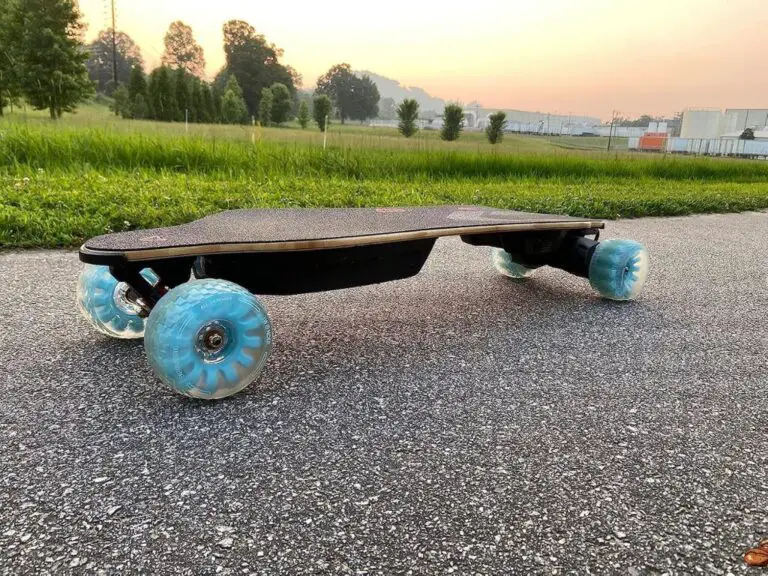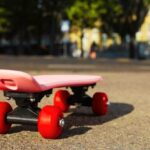When it comes to choosing between a longboard and a skateboard, many beginners find themselves confused. While both are popular forms of recreational transportation and sport, they have distinct differences in design, purpose, and riding style. In this comprehensive guide, we will take a deep dive into the world of longboards and skateboards, exploring their unique characteristics, components, and cultural aspects. By the end, you’ll have a clear understanding of which option suits your needs and preferences.
This article will break down the key differences between longboards and skateboards, helping you decide which one aligns best with your riding goals, experience level, and personal preferences. So, grab your virtual helmet and let’s get rolling!
Defining Skateboards and Longboards
Before we delve into the differences between longboards and skateboards, let’s start by defining these two distinct types of boards.
A skateboard is a smaller, more compact board primarily designed for tricks, jumps, and maneuvers in skateparks and urban environments. It typically measures around 28 to 32 inches in length and 7 to 10 inches in width. Skateboards have a symmetrical shape, featuring a concave deck with a raised nose and tail, known as the kicktail. The construction of a skateboard allows riders to perform flips, ollies, and other technical tricks.
On the other hand, a longboard is a longer and wider board designed for cruising, transportation, and downhill racing. Longboards often range from 33 to 60 inches in length and 8.5 to 10 inches in width. Unlike skateboards, longboards come in various shapes, including pintail, drop-through, and drop decks, each offering specific benefits for different riding styles. The larger size and stability of longboards make them ideal for smooth rides and carving.
Primary Differences
The key differences between longboards and skateboards can be summarized as follows:
- Purpose: Skateboards are primarily used for tricks, jumps, and skatepark riding, while longboards are designed for cruising, transportation, and downhill racing.
- Size and Shape: Longboards are longer and wider, offering more stability and a comfortable riding experience. Skateboards are smaller and more compact, allowing for greater control during tricks.
- Components: Longboards often feature larger and softer wheels for smoother rides and better grip, while skateboards have smaller and harder wheels for better maneuverability and trick performance.
- Cultural Differences: Skateboarding culture is known for its emphasis on creativity and pushing boundaries, while longboarding culture tends to be more laid-back and focused on cruising and enjoying the ride.
Now that we have a basic understanding of the differences between longboards and skateboards, let’s explore each type in more detail.

Key Differences: Longboard vs Skateboard
When it comes to board sports, longboards and skateboards offer distinct experiences. Let’s delve into the key factors that set them apart:
A. Size and Deck:
- Longboard: These bad boys are all about stability and smooth cruising. Their length, typically ranging from 35 to 59 inches, provides a larger platform for you to plant your feet and find your balance. Longboards also come in various deck styles, like drop-through (lower deck for pushing ease) and pintail (pointed tail for carving turns).
- Skateboard: These compact companions are champions of maneuverability. Their size, usually around 31 inches, makes them easier to carry and ideal for popping tricks. Skateboards feature a consistent deck with a kicktail at the end, perfect for launching into ollies and other aerial maneuvers.
B. Wheels:
- Longboard: Imagine gliding effortlessly! Longboards boast larger, softer wheels (typically 70mm and above) that eat up bumps and cracks, making your ride smooth and comfortable. These wheels also excel at building up speed for thrilling downhill adventures (if that’s your jam!).
- Skateboard: Grind kings and trick queens, rejoice! Skateboards have smaller, harder wheels (around 52mm and below) that prioritize responsiveness and control. These wheels allow for precise landings and snappy grinds on rails and ledges.
C. Riding Style:
- Longboard: Longboards are perfect for cruising along scenic paths, carving graceful turns, or even conquering downhill slopes (with proper safety gear, of course!). Their smooth ride and stability make them a great choice for beginners or those who prioritize comfort and long-distance rides.
- Skateboard: Skateboards are the go-to choice for mastering tricks, from basic ollies to gravity-defying flips. They shine in skateparks, where their maneuverability allows you to conquer ramps, rails, and bowls. Skateboards are also a popular choice for getting around town with a touch of freestyle fun.
Stay tuned for the next section where we’ll explore how these differences translate into choosing the right board for you!
Skateboards: Designed for Tricks and Skateparks
Skateboards are synonymous with tricks, jumps, and skatepark riding. They are the go-to choice for riders looking to perform technical maneuvers and showcase their skills. In this section, we will explore the components that make skateboards ideal for such purposes.
Skateboard Decks
The deck is the main platform of a skateboard, providing a sturdy and stable surface for riders to stand on. Skateboard decks are typically made of multiple layers of maple wood, known as ply, laminated together. The number of plies can vary, but the most common configuration is a 7-ply construction, providing a balance between strength and flexibility.
Skateboard decks have a symmetrical shape, commonly referred to as a “popsicle” shape. This shape allows riders to perform tricks in any direction and maintain balance during rotations. The deck features a concave design, which creates a curved shape along its length. This concavity improves grip and control, allowing riders to lock their feet in place while performing tricks.
One of the key features of a skateboard deck is the kicktail. The kicktail is the upturned portion at the back of the deck, while the front of the deck is known as the nose. The kicktail allows riders to pop the board off the ground, enabling tricks such as ollies, kickflips, and shove-its. The nose and kicktail are essential for performing technical maneuvers and adding flair to skateboarding tricks.
Trucks and Turning
Skateboard trucks are metal T-shaped components that attach the wheels to the deck. They play a crucial role in turning, stability, and grind performance. Trucks consist of several parts, including the baseplate, hanger, kingpin, bushings, and axle.
The baseplate is the part that attaches the truck to the skateboard deck. It is usually made of aluminum and is mounted with screws to secure it in place. The hanger is the T-shaped portion of the truck that holds the axle and the wheels. The hanger is the part that pivots and allows the skateboard to turn. The kingpin is a large bolt that holds the truck together and allows riders to adjust the tightness or looseness of their trucks. Bushings are rubber or urethane components that provide cushioning and control during turns.
Skateboard trucks are designed to be highly responsive, allowing riders to make quick and sharp turns. The turning ability of a skateboard depends on various factors, including the tightness of the kingpin, the size and hardness of the bushings, and the truck’s geometry. Riders can adjust these components to customize the turning characteristics of their skateboard according to their preference.
Wheels for Tricks
Skateboard wheels are essential for providing smooth rides, grip, and the ability to perform tricks. Skateboard wheels are typically made of polyurethane, a durable and grippy material that ensures a smooth roll. They come in various sizes, hardness levels (durometer), and shapes, each offering unique benefits for different riding styles.
For trick-oriented skateboards, smaller and harder wheels are preferred. Smaller wheels, typically ranging from 50mm to 59mm in diameter, provide greater maneuverability and allow riders to perform technical tricks with ease. Harder wheels, with a durometer rating of 95a and above, offer less grip, enabling slides and grinds on various surfaces, such as curbs and ramps.
The choice of skateboard wheels depends on the rider’s preference and the type of terrain they intend to ride. Street skateboarders often opt for smaller and harder wheels, while skateboarders who frequent skateparks may prefer slightly larger and slightly softer wheels for a smoother ride and better grip on transitions.
Bearings for Performance
Skateboard bearings are small, metal components that fit inside the wheels and allow them to spin freely. They consist of an outer ring, an inner ring, a set of balls, and a shield or cover to protect the internal components from dirt and debris. Bearings play a crucial role in the performance of a skateboard, determining how smoothly and efficiently the wheels spin.
The quality of skateboard bearings is typically measured by the ABEC (Annular Bearing Engineering Committee) rating. The ABEC rating system ranges from ABEC-1 to ABEC-9, with higher ratings indicating a higher degree of precision and smoothness. However, it’s important to note that ABEC ratings are not the only factor determining the quality of bearings, as they primarily measure the tolerance and precision of bearings in high-speed machinery rather than skateboarding.
Skateboard bearings are standardized and can be used interchangeably between skateboards and longboards. However, certain brands offer specialized bearings marketed as more suitable for longboarding due to their design features, such as built-in spacers and extended durability.
Now that we have explored the components that make up a skateboard, let’s move on to longboards and uncover their unique characteristics.
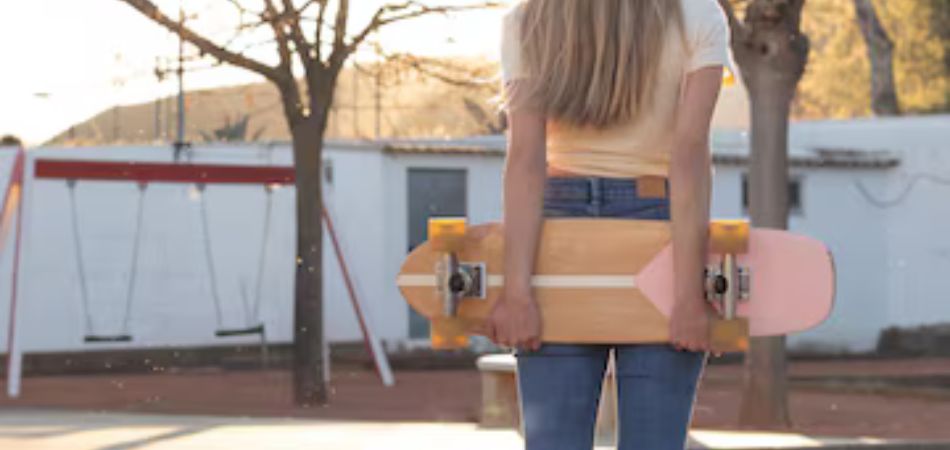
Longboards: Ideal for Cruising and Transportation
Longboards are designed with cruising, transportation, and downhill racing in mind. They cater to riders who prioritize smooth rides, stability, and comfort. In this section, we will dive into the components that make longboards excel in these areas.
Longboard Decks
The deck is the foundation of a longboard, providing a stable and spacious platform for riders. Longboard decks are typically longer and wider than skateboard decks, allowing for a more comfortable stance and greater stability at higher speeds. They come in various shapes and designs, each tailored to different riding styles and preferences.
One of the most common longboard deck shapes is the pintail, characterized by its narrow and tapered design resembling a surfboard. Pintails are popular for cruising and carving due to their responsive turning and stability. Another popular longboard shape is the drop-through, which features a cutout in the deck that allows the trucks to be mounted through the board. Drop-through decks provide a lower center of gravity, enhancing stability and making them ideal for downhill racing and freeriding.
Top-mount longboards, on the other hand, have their trucks mounted on the top of the deck, providing a higher ride height and increased maneuverability. These boards are often used for freestyle and dancing due to their enhanced agility. Additionally, drop decks have a lowered platform for a lower center of gravity, providing stability and control at high speeds.
Longboard decks are constructed using various materials, including bamboo, fiberglass, carbon fiber, maple, cork, and composites. Each material offers different benefits in terms of flexibility, durability, and overall performance. Riders can choose a deck material based on their preferences for ride quality and desired level of responsiveness.
Trucks for Stability and Carving
Just like skateboards, longboards use trucks to attach the wheels to the deck. However, longboard trucks are typically wider and more stable than skateboard trucks, providing better control and carving capabilities.
Longboard trucks come in various widths, with wider trucks offering more stability and narrower trucks providing greater maneuverability. The choice of truck width depends on the rider’s preference and the intended riding style. For cruising and transportation, wider trucks are often favored, as they provide a more stable platform for smooth rides. For more technical riding, such as freestyle or dancing, narrower trucks offer increased maneuverability for tricks and turns.
In addition to width, longboard trucks also vary in terms of the kingpin angle. The kingpin angle refers to the angle at which the kingpin, the large bolt holding the truck together, is positioned. Different kingpin angles affect the truck’s responsiveness and turning radius. Higher kingpin angles result in tighter turns, while lower kingpin angles provide a more stable and predictable ride.
Truck bushings also play a significant role in the performance of longboards. These rubber or urethane components provide cushioning and control during turns. Softer bushings allow for smoother and more fluid turns, while harder bushings provide stability and a more responsive ride. Riders can experiment with different bushing hardness levels to find the optimal setup for their riding style and preferences.
Wheels for Smooth Rides
One of the standout features of longboards is their larger and softer wheels, which provide a smooth and comfortable ride, especially on rough surfaces. Longboard wheels are typically made from polyurethane, like skateboard wheels, but they are larger and have a lower durometer rating for enhanced shock absorption.
Longboard wheels come in various diameters, usually ranging from 60mm to 85mm or more. The larger diameter allows longboard wheels to roll over cracks, pebbles, and other obstacles more easily, providing a smoother ride. The size of the wheels also contributes to stability at higher speeds, as larger wheels maintain momentum and handle uneven surfaces more effectively.
Additionally, longboard wheels have lower durometer ratings, typically ranging from 75a to 90a. The lower durometer rating indicates a softer wheel, which offers better grip and shock absorption. Softer wheels are advantageous for cruising and transportation, as they provide a more comfortable ride and better traction on various surfaces.
It’s worth noting that longboard wheels can vary in shape as well. Some wheels have a square-edged design, offering a larger contact patch for increased grip. Others feature rounded lips or beveled edges, allowing for smoother slides and easier initiation of drifts.
Bearings for Speed and Durability
Longboard bearings, like skateboard bearings, are essential for smooth rolling and overall performance. Bearings for longboards are standardized and can be used interchangeably with skateboard bearings. However, certain brands offer specialized longboard bearings with features tailored to longboarding preferences.
Longboard bearings often come with built-in spacers, which ensure proper alignment and spacing between the bearings. This feature prevents the bearings from compressing or loosening during riding, resulting in a smoother and more consistent roll. Built-in spacers also simplify the installation process, as the bearings can be easily aligned and inserted into the wheels without the need for additional spacers.
Durability is another important consideration for longboard bearings, especially for riders who frequently tackle high speeds and rougher terrain. Longboard bearings with enhanced durability features, such as increased corrosion resistance and improved sealing, can withstand the demands of downhill racing and freeriding. These bearings are designed to withstand harsh conditions and provide long-lasting performance, ensuring a smooth and enjoyable ride.
Now that we have explored the components that make up a longboard, let’s move on to the cultural differences between skateboarding and longboarding.
Cultural Differences: Skateboarding vs Longboarding
Skateboarding and longboarding have their unique subcultures and communities, each with its own style, attitude, and values. Understanding these cultural differences can provide insight into the motivations and preferences of riders in each discipline.
Skateboarding Culture
Skateboarding culture is characterized by its emphasis on creativity, individuality, and pushing the limits of what is possible on a skateboard. Skateboarders are constantly seeking new spots to ride, exploring their surroundings for unique obstacles and opportunities to showcase their skills. Skateboarding is often associated with urban environments, where riders use architecture and public spaces as their playground.
In skateboarding, style, trick difficulty, and innovation are highly valued. Skaters strive to develop their own unique style and interpretation of tricks, bringing a sense of personal expression to their riding. The skateboarding community thrives on camaraderie, with riders supporting and inspiring each other to progress and push their limits.
Skateboarding has gained mainstream popularity over the years, with professional skateboarders becoming household names and skateboarding events attracting global attention. The inclusion of skateboarding in the Olympic Games has further elevated its status and exposed the sport to a broader audience.
Longboarding Culture
Longboarding culture, while sharing some similarities with skateboarding culture, often has a more relaxed and laid-back vibe. Longboarders typically prioritize the joy of cruising, the sensation of carving through turns, and the freedom of exploring their surroundings. Longboarding is often associated with coastal areas, where riders can enjoy scenic rides along beachfronts or winding roads.
The longboarding community values the sense of freedom and flow that comes with riding a longboard. Longboarders often seek out smooth, open roads for extended rides, appreciating the feeling of gliding effortlessly and taking in the scenery. Longboard events and gatherings often focus on group rides, bringing riders together to enjoy the shared experience of longboarding.
Longboarding covers a wide range of disciplines, including cruising, carving, dancing, freestyle, and downhill racing. Each discipline has its own unique style and community, but all share a common love for the smooth, flowing nature of longboarding. Longboarders often embrace a more holistic approach to riding, combining elements of surfing, snowboarding, and other board sports.
While skateboarding has gained more mainstream recognition, longboarding remains more of a niche activity. However, the longboarding community continues to grow and attract riders of all ages and backgrounds who appreciate the freedom and joy that longboarding brings.
Now that we have explored the cultural aspects of skateboarding and longboarding, let’s compare their performances in terms of speed and maneuverability.
Performance Comparison: Speed and Maneuverability
Skateboards and longboards offer different performance characteristics, each suited to specific riding styles and preferences. In this section, we will compare their performance in terms of speed and maneuverability to help you make an informed decision.
Longboards: The Need for Speed
Longboards are known for their speed and stability, making them the preferred choice for riders looking to travel long distances, commute, or tackle downhill runs. The longer wheelbase, larger wheels, and lower center of gravity of longboards contribute to their exceptional stability at high speeds.
The larger wheels of longboards allow them to maintain momentum and roll over cracks and bumps more easily, resulting in a smoother ride. The longer wheelbase provides increased stability, reducing the chances of speed wobbles or loss of control. Additionally, the lower center of gravity, achieved through drop-through or drop deck designs, enhances stability and control, especially during downhill runs.
Longboarding disciplines such as downhill racing and freeriding focus on achieving maximum speed and maintaining control while navigating challenging terrains. Riders in these disciplines often wear specialized safety gear, such as full-face helmets and slide gloves, to protect themselves during high-speed descents and slide maneuvers.
Skateboards: Nimble and Agile
Skateboards are known for their maneuverability and agility, making them ideal for performing tricks, jumps, and technical maneuvers. The smaller size and lighter weight of skateboards contribute to their quick and responsive handling, allowing riders to navigate tight spaces and perform intricate tricks.
Skateboards excel in their ability to make sharp turns and quick directional changes, thanks to their narrower width and shorter wheelbase. The symmetrical shape of skateboard decks enables riders to perform tricks in any direction, while the kicktail provides leverage for popping the board off the ground and executing various maneuvers.
Skateboarding disciplines such as street skating and skatepark riding prioritize technical tricks, creativity, and a mix of flat ground maneuvers and obstacles. Riders in these disciplines often seek out urban environments, searching for skate spots such as stairs, handrails, ledges, and ramps to showcase their skills.
While longboards may not match skateboards in terms of maneuverability and trick performance, it’s worth noting that skateboarders can still cruise and ride long distances on their boards, and longboarders can perform tricks on their longboards. The choice between a longboard and a skateboard ultimately depends on the rider’s priorities and the type of riding they intend to pursue.
Now that we have compared the performance aspects of longboards and skateboards, let’s explore their popularity and the inclusion of women riders in each discipline.
Popularity: Skateboarding Takes the Lead
Skateboarding has been at the forefront of alternative sports and youth culture for decades, capturing the attention of millions of riders worldwide. The sport’s popularity has grown significantly, thanks to the mainstream exposure gained through professional skateboarders, skateboarding events, and media coverage.
Skateboarding has seen a surge in popularity with the inclusion of skateboarding events in major competitions such as the X Games and the recent addition of skateboarding as an official sport in the Olympic Games. These milestones have brought greater recognition to the sport and have attracted a broader audience.
Skateboarding’s popularity is also reflected in the growth of skateboarding brands, the development of skateboarding parks and facilities, and the rise of skateboarding culture in music, art, and fashion. Skateboarding’s influence extends beyond the sport itself, shaping trends and influencing youth culture worldwide.
On the other hand, longboarding has remained a niche activity, attracting a dedicated community of riders who appreciate its unique characteristics and riding style. While not as widely recognized as skateboarding, longboarding has gained a loyal following, particularly among riders seeking a more relaxed and enjoyable riding experience.
Longboarding has its own subcultures and communities, with riders often organizing group rides, events, and gatherings to share their love for the sport. Longboard brands and manufacturers cater to the specific needs and preferences of longboarders, producing a wide range of longboard decks, trucks, wheels, and other components.
Despite its niche status, longboarding continues to grow in popularity, with more riders discovering the joy of cruising, carving, and downhill racing. The inclusion of women riders in both skateboarding and longboarding has also contributed to the growth and diversity of these sports.

Women Riders: Empowering Female Skaters
In recent years, there has been a significant increase in the number of women participating in skateboarding and longboarding. Female riders have made significant contributions to both sports, breaking barriers and inspiring the next generation of riders.
Women in Skateboarding
Skateboarding has seen a surge in female participation and recognition, with talented female skaters making their mark in professional competitions, videos, and social media. Skaters such as Leticia Bufoni, Nora Vasconcellos, and Brighton Zeuner have become influential figures in the skateboarding world, showcasing their skills and inspiring young girls to pursue skateboarding.
The rise of female skateboarding has led to the development of initiatives and organizations focused on promoting inclusivity and empowering female skaters. Skateboarding events and competitions now feature women’s categories, providing a platform for female riders to showcase their talents and compete at the highest level.
Women in Longboarding
Longboarding has also seen an increase in female riders, with women embracing the sport’s freedom, flow, and community. Female longboarders have emerged as influential figures, pushing the boundaries of what is possible on a longboard and inspiring others to join the community.
Organizations and communities such as Grlswirl have been instrumental in creating a supportive and inclusive space for female riders in the longboarding world. These platforms provide opportunities for female longboarders to connect, share their experiences, and organize rides and events.
The growth of women’s participation in both skateboarding and longboarding has paved the way for increased representation, diversity, and inclusivity in these sports. Female riders continue to challenge stereotypes, break barriers, and inspire others to pursue their passions.
Now that we have explored the rise of women riders in skateboarding and longboarding, let’s discuss the factors to consider when choosing between a longboard and a skateboard.
Longboard vs Skateboard: Which Should You Choose?
Choosing between a longboard and a skateboard ultimately depends on your personal preferences, riding style, and intended use. Here are some factors to consider when making your decision:
- Riding Style: Determine whether you prefer cruising, transportation, downhill racing, or performing tricks and jumps. Longboards are ideal for cruising and transportation, while skateboards excel in trick performance and skatepark riding.
- Terrain: Consider the type of terrain you’ll be riding on. If you’ll be navigating smooth, open roads or bike paths, a longboard may be the more suitable choice. If you’ll be tackling urban environments with various obstacles, a skateboard may offer better maneuverability.
- Stability vs Maneuverability: Longboards provide greater stability and control, making them suitable for riders seeking a smooth and stable ride. Skateboards offer enhanced maneuverability and agility, allowing for quick turns and technical tricks.
- Speed: If speed is a priority, longboards are better equipped for high-speed descents and long-distance rides. Skateboards are more focused on technical tricks and street skating, where speed may not be the primary objective.
- Size and Portability: Consider the size and portability of the board. Longboards are larger and may be less convenient to carry or store compared to smaller, more compact skateboards.
By carefully considering these factors, you can make an informed decision about whether a longboard or a skateboard is the right choice for you. To further assist you in your decision-making process, here are some recommended options for both longboards and skateboards.
Recommended Skateboards
- 💰 Best Value: Stoked Ride Shop Complete
- Hand-built in California
- Comes with premium Dragon BUILT Bearings
- Includes a bonus tool and wax
- Available at Stoked Ride Shop and Amazon
- 🏆 Best Overall: Arbor Whiskey Series
- Features high-quality Ace Trucks
- Offers various widths and graphics
- Provides a great balance between performance and price
- Available at Stoked Ride Shop and Amazon
- 🤙🏼 Staff Pick: Tony Hawk Birdhouse Falcon 1
- Classic skateboard deck design
- Remembered from Tony Hawk Pro Skater
- Offers a range of components with a classic deck
- Available at Stoked Ride Shop and Amazon
Recommended Longboards
- 💰 Best Value: Sector 9 Meridian
- One of the OG longboard brands
- Provides a great balance of price and performance
- Available at Stoked Ride Shop and Amazon
- 🏆 Best Overall: Arbor Mission
- Features high-quality Paris 150mm Trucks
- Offers excellent value for the price
- Available at Stoked Ride Shop and Amazon
- 🤙🏼 Staff Pick: Landyachtz Drop Hammer
- Drop-through design for a lower center of gravity
- Ideal for cruising and commuting
- Available at Stoked Ride Shop and Amazon
While these recommendations provide a starting point, it’s important to consider your individual preferences and consult with experienced riders or local skate shops to find the best fit for your needs.
Who Should Choose Which: Examples
Here’s a quick breakdown to help you visualize which board might be the perfect fit for you:
Who Should Choose a Longboard?
- You crave smooth, comfortable rides for cruising long distances or commuting.
- You’re a beginner looking for a stable platform to learn the basics of balance and pushing.
- You enjoy carving graceful turns and exploring scenic paths.
- You’re interested in the thrill of downhill riding (with proper safety gear, of course!).
Who Should Choose a Skateboard?
- You dream of mastering tricks like ollies, kickflips, and grinds.
- You frequent skateparks and crave the challenge of conquering ramps, rails, and bowls.
- You value portability and the ability to navigate tight spaces easily.
- You enjoy getting around town with a touch of freestyle fun.
Cruiser Boards: A Middle Ground Option
If you can’t quite decide between cruising and some light tricks, consider a cruiser board. They offer a happy medium:
- Slightly larger and more stable than skateboards, providing a comfortable ride for cruising.
- Still offer some maneuverability for casual tricks like carving and pushing.
Remember, this is just a guide! There are no hard and fast rules. You can always try both longboards and skateboards to see which one feels more natural and enjoyable for you.
Conclusion: Ride On!
We’ve cruised through the key differences between longboards and skateboards, explored factors to consider when choosing your perfect ride, and even provided some examples to help you visualize the ideal fit.
Longboard vs Skateboard: Shred-tastic FAQs
Are longboards easier to learn than skateboards?
Generally, yes! Longboards offer more stability due to their larger size, making them easier to balance for beginners.
Can I do tricks on a longboard?
Absolutely! While skateboards are more specialized for tricks, some longboard styles like dancing longboards allow for freestyle maneuvers.
Which is faster, a longboard or skateboard?
Longboards can potentially reach higher speeds due to their larger wheels, but skateboards excel in acceleration and responsiveness.
Is a longboard good for commuting?
If your commute involves smooth surfaces, a longboard is a comfortable and efficient option. Their stability and larger wheels make them great for conquering cracks and bumps.

